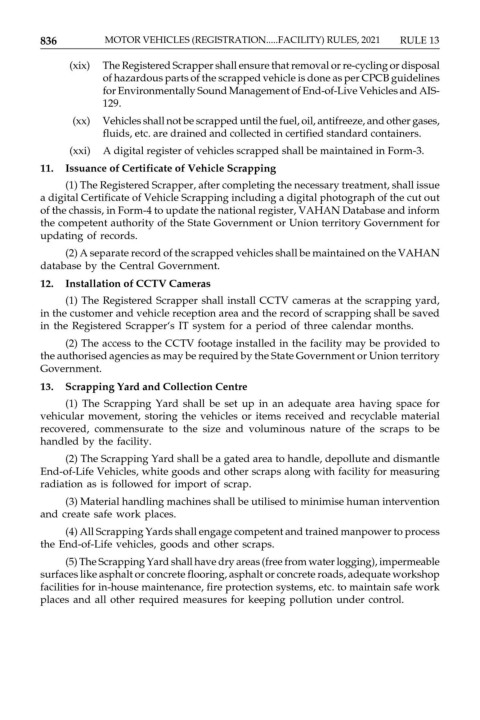Page 864 - The Central Motor Vehicles Rules, 1989
P. 864
836 MOTOR VEHICLES (REGISTRATION.....FACILITY) RULES, 2021 RULE 13
(xix) The Registered Scrapper shall ensure that removal or re-cycling or disposal
of hazardous parts of the scrapped vehicle is done as per CPCB guidelines
for Environmentally Sound Management of End-of-Live Vehicles and AIS-
129.
(xx) Vehicles shall not be scrapped until the fuel, oil, antifreeze, and other gases,
fluids, etc. are drained and collected in certified standard containers.
(xxi) A digital register of vehicles scrapped shall be maintained in Form-3.
11. Issuance of Certificate of Vehicle Scrapping
(1) The Registered Scrapper, after completing the necessary treatment, shall issue
a digital Certificate of Vehicle Scrapping including a digital photograph of the cut out
of the chassis, in Form-4 to update the national register, VAHAN Database and inform
the competent authority of the State Government or Union territory Government for
updating of records.
(2) A separate record of the scrapped vehicles shall be maintained on the VAHAN
database by the Central Government.
12. Installation of CCTV Cameras
(1) The Registered Scrapper shall install CCTV cameras at the scrapping yard,
in the customer and vehicle reception area and the record of scrapping shall be saved
in the Registered Scrapper‘s IT system for a period of three calendar months.
(2) The access to the CCTV footage installed in the facility may be provided to
the authorised agencies as may be required by the State Government or Union territory
Government.
13. Scrapping Yard and Collection Centre
(1) The Scrapping Yard shall be set up in an adequate area having space for
vehicular movement, storing the vehicles or items received and recyclable material
recovered, commensurate to the size and voluminous nature of the scraps to be
handled by the facility.
(2) The Scrapping Yard shall be a gated area to handle, depollute and dismantle
End-of-Life Vehicles, white goods and other scraps along with facility for measuring
radiation as is followed for import of scrap.
(3) Material handling machines shall be utilised to minimise human intervention
and create safe work places.
(4) All Scrapping Yards shall engage competent and trained manpower to process
the End-of-Life vehicles, goods and other scraps.
(5) The Scrapping Yard shall have dry areas (free from water logging), impermeable
surfaces like asphalt or concrete flooring, asphalt or concrete roads, adequate workshop
facilities for in-house maintenance, fire protection systems, etc. to maintain safe work
places and all other required measures for keeping pollution under control.

